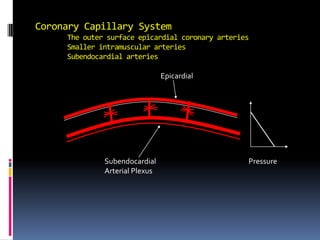
Lec61[1]
- 1. Coronary Capillary System The outer surface epicardial coronary arteries Smaller intramuscular arteries Subendocardial arteries Epicardial Subendocardial Arterial Plexus Pressure
- 2. Control of Coronary Blood Flow Local Muscle Metabolism is the Primary Controller of Coronary Flow Blood flow through the coronary system is regulated by local arteriolar vasodilation in response to cardiac muscle need for nutrition Whenever the vigor of cardiac contraction is increased, the rate of coronary blood flow also increases
- 3. Oxygen Demand as a Major Factor in Local Coronary Blood Flow Regulation About 70 % of the oxygen in the coronary arterial blood is removed as the blood flows through the heart muscle Coronary sinus blood has lower oxygen content than any other place in the cardiovascular system The coronary blood flow does increase almost in direct proportion to any additional metabolic consumption of oxygen by the heart.
- 4. Adenosine released from myocardial muscle cells in response to increased metabolic rate may be an important local coronary metabolic vasodilator influence
- 5. Nervous Control of Coronary Blood Flow The direct stimulation result from action of the acetylcholine from the vagus nerves and norepinephrine and epinephrine from the sympathetic nerves on the coronary vessels themselves The indirect stimulation result from secondary changes in coronary blood flow caused by increased or decreased activity of the heart. The indirect effects play a far more important role in normal control of coronary blood flow
- 6. Ischemic Heart Disease Results from insufficient coronary blood flow The most frequent cause of diminished coronary blood flow is atherosclerosis Large quantities of cholesterol deposited beneath the endothelium at many points in arteries throughout the body The net result is the development of atherosclerotic plaquesthat actually protrude into the vessel lumens
- 9. Mechanism of Atherosclerosis LDL build up Plaque Flow Rupture Clot Blocked flow Tissue death
- 10. Basal Coronary Requirements Coronary muscle gets about 8 ml/min/100 g of tissue. To stay alive it needs about 1.3 ml/min/100 g. The heart can remain alive at ~20% of its normal flow. Subendothelium is usually the first to go because of high compression.
- 11. Myocardial Infarction (Heart Attack) Atheroscelrosis (Athere: “Gruel”; Sclerosis: “Hardening”) Thrombosis: Sudden occlusion or embolus. Local spasm Slowly progressing disease allows collaterals to be developed. The area of muscle that has either zero flow or little flow that it can not sustain cardiac muscle function is said to be infarcted The overall process called myocardial infarction
- 12. Causes of Death by Heart Attack Decreased cardiac output – shock. Failure of kidneys to excrete enough urine. Ventricular fibrillation (post-event): Rapid depletion of potassium Injury current (muscle cannot repolarize) Sympathetic reflex stimulation Abnormal conduction.
- 13. Cerebral blood flow Normal blood flow through the brain of adult person averages 50 – 65 ml/100 gm/min or 15% of resting cardiac output
- 14. Three metabolic factors control cerebral blood flow Carbon dioxide concentration Hydrogen ion concentration Oxygen concentration
- 15. Increase of cerebral blood flow in response to excess CO2 and H ion concentration Cerebral blood flow increase whenever (PCO2) is raised above normal in the arterial blood Increases the acidity in the brain tissue and therefore increases hydrogen ion concentration will increase cerebral blood flow Higher than normal arterial blood PO2 produces little decrease in cerebral blood flow
- 16. Autoregulation of cerebral blood flow when arterial pressure changes Cerebral blood flow regulated by local mechanism Flow through the cerebrum is autoregulated strongly and little affected by changes in arterial pressure unless it increased as high as 140 mmHg or falls below 60 mm Hg
- 17. Role of sympathetic nervous system in controlling cerebral blood flow The cerebral vessels receive both sympathetic vasoconstrictor and parasympathetic vasodilator fiber innervation Cerebral blood flow is influenced very little by changes in the activity of either because the blood flow autoregulation mechanism Sympathetic vasoconstrictor responses could be important in protecting cerebral vessels from excessive distention following high arterial pressure
- 18. Cutaneous blood flow The metabolic activity of body cells produces heat that must be lost in order for the body temperature remain constant The skin is the primary site of exchange of body heat with the external environment Cutaneous blood flow, which is about 6% of the resting cardiac output can be decreased when heat is to be retained and increases when heat is to be lost
